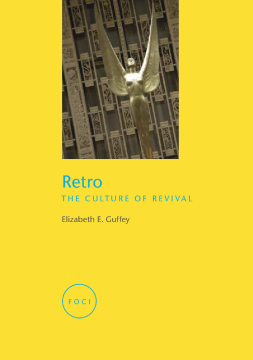
Additional Information
Book Details
Abstract
Bell-bottoms are in. Bell-bottoms are out. Bell-bottoms are back in again. Fads constantly cycle and recycle through popular culture, each time in a slightly new incarnation. The term “retro” has become the buzzword for describing such trends, but what does it mean? Elizabeth Guffey explores here the ambiguous cultural meanings of the term and reveals why some trends just never seem to stay dead.
Drawing upon a wealth of original research and entertaining anecdotal material, Guffey unearths the roots of the term “retro” and chronicles its evolving manifestations in culture and art throughout the last century. Whether in art, design, fashion, or music, the idea of retro has often meant a reemergence of styles and sensibilities that evoke touchstones of memory from the not-so-distant past, ranging from the drug-induced surrealism of psychedelic art to the political expression of 1970s afros.
Guffey examines how and why the past keeps coming back to haunt us in a variety of forms, from the campy comeback of art nouveau nearly fifty years after its original decline, to the infusion of art deco into the kitschy glamor of pop art, to the recent popularity of 1980s vogue. She also considers how advertisers and the media have employed the power of such cultural nostalgia, using recycled television jingles, familiar old advertising slogans, and famous art to sell a surprising range of products.
An engrossing, unprecedented study, Retro reveals the surprising extent to which the past is embedded in the future.
"What happens when a stylistic revival is neither merely ironic nor flooded with sentimentality? Elizabeth Guffey considers retro's resistance to modernist progressive cheerleading and, in fact, its rewriting of modernism itself. Deftly drawing from popular culture, consumerist trends, and design history, Guffey has created a great read and a challenging history in her brave, dizzying, and entirely useful study." — Maud Lavin, professor of Visual and Critical Studies and Art History, Theory and Criticism, The School of the Art Institute of Chicago, and author of Clean New World: Culture, Politics, and Graphic Design
"[An] enjoyable exploration of retro chic. . . . Guffey offers an intriguing investigation of our seduction by the past."
— Christopher Hirst, The Independent"Provides an interesting take on the various rapidly recycling revivals of the late 20th century. . . . A thought-provoking read - it weaves in lots of fresh and stimulating material which adds to our understanding of the complexities of post war cultural life."
— Catherin Croft, Building Design"In this informative and lively book, Elizabeth Guffey cuts through the ambiguities of the term retro and examines its roots, evolution and myriad manifestations. . . . Throughout, the book seeks to understand how and why the recent past has been transformed into a revolving door of pop historicism. . . . Based on considerable original research and including rich anecdotal material, the book is aimed at all readers interested in retro as well as twentieth-century art, design and consumer culture." — Concept for Living
Elizabeth Guffey is associate professor of art and design history at Purchase College, State University of New York and is also vice president of the Design Studies Forum. She is the author of Drawing an Elusive Line: The Art of Pierre-Paul Prud’hon, and writes regularly on the history and criticism of nineteenth- and twentieth-century art and design.
